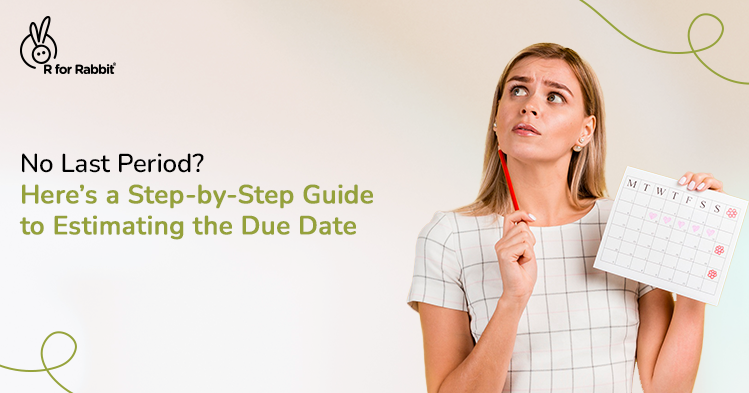How To Estimate A Pregnancy Due Date Without Knowing The Date Of Your Last Period

Table of Contents
“When is the baby due?” “Are you ready for the big day?” “Did you pack a bag for the hospital?” Some are among the few questions expectant parents hear during the months of expecting a little munchkin!
All of these demand knowledge of due dates which is usually determined by the date of a woman’s last menstrual period (LMP). That is the first day of her last menstrual cycle. This method is considered effective for regular menstruating women.
But, what if you have an irregular menstrual cycle?
Well, in that case, various other methods are used for the estimation of the due date.
This blog is a guide for all expectant parents on how to estimate pregnancy due dates without knowing the last period date.
Section 1: Common Methods of Calculating Due Dates
I. Method 1: Using LMP-Based Calculations
This is the most traditional method that was used to calculate the due date. It is considered a normal 28-day menstrual cycle where ovulation occurs on the 14th day.
Here, 40 weeks is taken as the normal gestational age, thus adding up to 280 days from the date of LMP, gives the estimated due date.
For example, if the last period in your case was November 7, 2024, the due date is August 14, 2025.
II. Method 2: The Role of Ovulation And The Dates of Conception
This method comes into the picture when the date of the LMP is unknown or in case of an irregular menstrual cycle.
Methods For Estimating Ovulation at Irregular Intervals
While the traditional LMP procedure may seem complicated, various methods can be used to monitor ovulation in women.
- Ovulation Predictor Kit (OPK)
These kits are very helpful in monitoring ovulation based on the presence of LH hormone in the urine. It is easier to notice the surge if your menstruation is regular.
In case of an irregular menstrual cycle, it is important to begin testing almost a week early to notice the LH surge in the body.
Also, having multiple tests in a day can help you understand your optimum LH surge. Some women tend to have it higher in the morning.
- Basal Body Temperature (BBT)
A mild rise follows ovulation in resting body temperature. This is the body temperature right after you wake up.
The release of progesterone results in a slight rise in the body temperature, which can be determined either physically or with a specially designed BBT thermometer.
Tips for irregular periods:
- Track the temperature regularly at the same time and under the same situations. This is because our physical movement also regulates the body temperature.
- To obtain an appropriate result, keep tracking it for a few months to understand your temperature changes during ovulation.
- Cervical Mucous Monitoring
Our cervical mucous tends to become clear, stretchy, and slippery just before ovulation. This happens for the easier movement of the sperm inside the uterus.
This is also known as white discharge and is seen in the panty or by feeling inside your vagina with your fingers. Thick mucous pertains to ovulation time, which means high fertility days.
- Fertility Apps
Various fertility apps can help you track your ovulation. They are effective since they keep track of the combination of LMP, BBT, OPKs, cervical mucous, etc., to determine the exact dates of ovulation, conception, and due date.
These are some of the essential ways on how to calculate the due date without knowledge about the last period date.
Section 2: Effective Alternatives Without LMP
I. Early Ultrasound Scans
Ultrasound is the best alternative method for a due date calculation manually or by using a calculator for irregular periods.
This is because it measures the size of the head to the bottom of the fetus, also known as crown-rump length. This size helps in determining the gestational age accurately.
One of the best times to do this is between 6 to 12 weeks of pregnancy for reliable gestational data.
Also, early ultrasounds during the first trimester are always considered the best. This is because after certain weeks the growth of the fetus is distinctly visible. It thereby helps in detecting various other growth and developmental stages of the fetus.
II. Using Fertility Tracking or Conception Date
Following the date of ovulation or pregnancy may be useful when LMP is unknown or cannot be diagnosed due to menstrual irregularities.
You notice ovulation just two weeks after your last period. Therefore, adding 266 days or 38 weeks to the date of ovulation or pregnancy can help determine the exact date of birth.
For example, if you ovulate on November 20, 2024, it generally takes 12 to 24 hours for the egg to ovulate, which is November 21, 2024.
In Vitro Fertilization (IVF)
During IVF discourse, healthcare professionals closely keep track of ovulation to determine the right time for fertilization. This helps in easy accessibility for pregnancy due date calculation with a calculator and without LMP.
It is divided into two based on the embryo transfer after fertilization. That is:
|
Transfer After Fertilization |
Days Added For Due Date Calculation |
|
After 3 days |
(Date of transfer+ 261 days) |
|
After 5 days |
(Date of transfer+ 263 days) |
III. Physical and Developmental Milestones
The regular monitoring of the fetus's growth and development throughout the three trimesters also helps in assessing the due date.
- First trimester: The foremost thing formed in a fetus is the heartbeat by around 8 weeks. This is followed by the development of limbs, fingers, and toes by around 10 weeks and basic features like eyes, ears, and nose by around 12 weeks. It is during this period that ultrasound reveals the true gestational age.
- Second Trimester: During the 16th week, the first movement can be slightly felt, which intensifies around the 20th week. Around 18 weeks, the fetus’ sensory organs are developed, thus helping it to identify sound, touch, smell, and taste. It is also during this period that an ultrasound is performed to check for possible abnormalities.
- Third Trimester: This period facilitates the development of the lungs. Also, the position of the baby moves head-down, ready for delivery at around 30 weeks. At 40 weeks, the fetus is usually fully developed and ready to see the new world!
However, this is a normal process, and individual due dates may vary depending on the circumstances. Also, only 4% of children are born on their estimated due date.
Section 3: Online Pregnancy Due Date Calculators
I. Key Features Of Online Tools
The growing popularity of various online tools has certainly made our lives easier.
Among them, pregnancy planning tools are on a rising surge of acceptance and recognition.
R for Rabbit’s Pregnancy Due Date Calculator
All you have to do is input the last menstrual period date and average menstrual cycle or just the date of conception. Thus, receiving your personalized pregnancy journey.
The result ranges from the date of conception, division of trimesters, and milestones of fetal development to multiple due dates, each for a singleton, twins, triplets, or quads.
The authenticity of the result might vary depending on your circumstances and the growth and development of the fetus.
Also, there are a range of other pregnancy planning and associated tools like online pregnancy tests, period calculators, and contraction calculators, which you can access during your various stages of pregnancy,
Irrespective of their approximation, they provide great help in planning for hospital visits, efficient nutrition, and tonnes of shopping before D-day!
Limitations of Calculators Without LMP
One of the most common limitations is improper calculation due to confusion or forgetfulness of LMP or irregular menstrual cycle.
Therefore, always consider consulting your healthcare expert for a more trustworthy result. This would also keep you prepared for the future.
II. Recommended Indian Tools
There are also some other recommended Indian tools and accurate pregnancy calculators for Indian users.
These are brought up by Motherhood Hospital, Pampers India, Mom Junction, Max Healthcare, Baby Centre, and many more.
Section 4: Addressing Variability in Pregnancy Length
I. Typical Gestation Range
The normal gestational age ranges from 38 to 41 weeks, with an average of 40 weeks.
Depending upon the timing of birth, the delivery can be categorized into:
- Preterm Delivery: Happens before 37 weeks.
- Term Delivery: Happens at 40 weeks.
- Postterm Delivery: Happens after 42 weeks.
Factors Influencing The Timing Of Delivery
There are variable reasons for multiple timings of delivery, like:
- Irregular menstrual cycle: The inconsistency of the menstrual cycle impacts the date of ovulation and conception, thus influencing the due date.
Therefore, the number of days of individual menstrual cycles acts as the precursor to determine other pregnancy factors.
|
Menstrual Cycle |
Conception |
Pregnancy Duration |
|
>28 Days |
Early |
Short |
|
<28 Days |
Late |
Long |
- Age: For women above the age of 35, the chances of having a post-term birth increase. This can be harmful to both the mother and baby.
- Equity: Women who have given birth in the past tend to have shorter labor or early births compared to first-time mothers.
- Health conditions: There are certain health factors associated with pregnancy that compel healthcare providers to make personalized decisions. This includes:
|
Medical Condition |
Impact on Pregnancy |
|
Gestational Diabetes |
Larger babies and a risk of post-term delivery |
|
Hypertension/Preeclampsia
|
Induce early labor to protect both the mother and the baby |
|
Obesity |
High risk of post-term delivery |
Other factors that play a role in the timing of birth include genetics, fetal growth stage, stress, nutrition, environment, and fitness activities during pregnancy.
II. Importance of Personalised Care
Despite the normal gestational age, it is very important to have regular prenatal checkups to make timely decisions depending on the stage and condition of the pregnancy.
For example, in the case of early detection of pregnancy complications or the case of high chances of post-term delivery, the risk of stillbirth, abnormalities during birth, etc., increases. This can be avoided with regular checkups, followed by timely actions.
Conclusion
In the current times, with the rise of PCOD and PCOS, the menstrual cycle has lagged to a great extent, making the due date estimation harder.
In these instances, several other approaches can be employed to arrive at a rough estimate of the due date.
Among the many pregnancy planning tools, the best pregnancy calculators are the ones that consider all possibilities such as LMP, ovulation, pregnancy, ultrasound, and more
Finally, no matter how accurate a tool may be, there is no substitute for routine prenatal testing and advice from individual health professionals.








